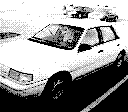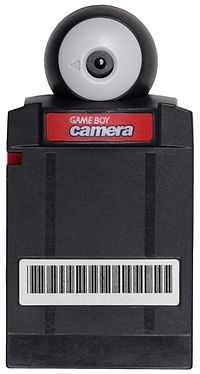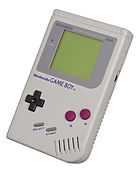Game Boy Camera
|
A red Game Boy Camera. Various other colors were also available. | |
| Manufacturer | Nintendo |
|---|---|
| Type | Camera |
| Generation | Fourth generation era |
| Retail availability | |
The Game Boy Camera, released as Pocket Camera (ポケットカメラ) in Japan, is an official Nintendo accessory for the handheld Game Boy gaming console and was released in 17 September 1998 in Japan, which ceased manufacture in late 2002. It is also compatible with all of the Game Boy platforms (with the exception of Game Boy Micro). The camera can take 256×224 (down scaled to half resolution on the unit with anti-aliasing), black & white digital images using the 4-color palette of the Game Boy system. The focal length is 20 cm.[2] It interfaced with the Game Boy Printer, which utilized thermal paper to print any saved images, making a hardcopy. Both the camera and the printer were marketed by Nintendo as light-hearted entertainment devices aimed mainly at children in all three major video game regions of the world: Japan, North America, and Europe. N64 Magazine (which has since been superseded by NGamer) dedicated a monthly section to the device.
The Game Boy Camera comes in five different standard colors: blue, green, red, yellow and clear purple (Japan only). There was also a limited edition gold The Legend of Zelda: Ocarina of Time edition, which contains different stamps from the standard versions and was available only in the United States through a mail order offer from Nintendo Power.
The device's software has numerous references to other Nintendo products. Also, there are a few differences between the North American and Japanese versions, including the unlockable B album pictures and the stamps that can be placed on pictures.[3]
The Game Boy Camera was featured in the 1999 edition of Guinness World Records for being the world's smallest digital camera, though this record has since been broken. Nintendo reportedly had plans to release a successor to the Game Boy Camera for the Game Boy Advance called the GameEye[4] which would take color photos and feature connectivity with the Nintendo GameCube through a game titled Stage Debut, but neither the GameEye nor Stage Debut ever saw release.
Features

There are three main options available on the menu screen: Shoot, View, and Play.
Shoot
The first option in the menu screen is Shoot and offers various features. The first feature is the titular "Shoot" feature in which allows users to take photos instantly. Up to 30 pictures can be saved.
The second feature is "Items" option in which offers two additional options: Self-Timer and Time-Lapse. Self-Timer offers taking pictures automatically after a delay. Time-lapse offers taking pictures automatically at regular intervals. the time intervals and number of shots can be customized.
The third feature is "Magic" and offers four additional options: Trick, Montage, Panorama, and Game Face. Trick offers users taking pictures with mirror and zoom effects, Montage offers taking multiple pictures and mixing them together, Panorama offers taking pictures and combining them into a row or column, Game Face allows users to take four different shots of the user's face that will appear in the camera's game.
The fourth and fifth features are "Check" and "Run". Check allows users to view the pictures taken. Run is a prank feature.
View
The second option in the menu screen is View and contains the following features: Album and Show. Album offers the user to view albums stored in memory. View offers three additional options: Slideshow, Animation, and Hot-Spot. Slideshow allows users to display and edit a slide show of the album available. Animation allows users to choose background music and view pictures in sequence to make it look like they are moving.
Hot-Spot allows users to link pictures together by clicking on certain spots of the picture. This can be used in a number of creative ways. For example, it could be used for creating a game where a player can go from one photo of a room in a house to another by pressing certain spots on the photos. The location of the hot-spots are customizable by accessing the Special menu via the Select options and choosing "Hot-Spot". In this mode, up to five one-eyed blobs can be placed on each picture, which become invisible hot-spots during "Hot-Spot" mode. Each blob can be programmed to send the player to a different photo and include a visual transition and a sound effect. Then, in Hot-Spot mode, when the player presses one of the hot-spots, he or she will be sent to a photo of another room, where additional hot-spots will send the player to additional photos, and move him or her throughout the virtual house.
Play
Play is a built-in Space Fever II minigame, which is the sequel to the Space Fever arcade game created by Nintendo. At the beginning of the game, two spaceships will appear, one marked with a "B" and one with a "D". Shooting the "B" ship will send players to the Ball minigame. Shooting the "D" ship will send players to DJ mode, an open-ended music video game. By avoiding both of the ships, the player will begin playing Space Fever II. After scoring 2,000 points in Space Fever II, a new minigame called Run! Run! Run! will be unlocked. Once unlocked, a new ship marked with a "?" will appear alongside the "B" and "D" ships at the beginning of each new game of Space Fever II. Access Run! Run! Run! by shooting the "?" ship.
- Ball is a juggling game, in which the player moves his or her hand around to catch and throw balls. It is very similar to the Game & Watch game of the same name, only with Mr. Game & Watch's head replaced with the "Game Face". Interestingly, the background music to this game is "Mayim Mayim," an Israeli folk song.
- DJ is a music sequencer known as "Trippy-H" where players can mix and create their own simple chiptunes. The "Game Face" is the DJ.
- Space Fever II is an homage/sequel to an early Nintendo arcade game. In this minigame, the player controls a spaceship which fires missiles at other ships throughout three unique levels, followed by a boss at the end of each level. The first boss is a giant face of a man with horns, the second boss is a giant face of a mustachioed man, and the third boss is the "Game Face". Once all three of the bosses are beaten, the cycle will start over again, only harder.
- Run! Run! Run! is the bonus minigame, which is obtained by reaching a score of 2,000 or more in Space Fever II. The "Game Face" is attached to a cartoon body, and the player races against a mole and a bird for the finish line.
"Start" and "Select" options
When the "select" button is pressed, two options appear: Doodle, Link, Special, and Edit. Doodle offers one to draw on a picture previously photographed and decorating them with stamps. The Link option offers printing options to print a photo using the Game Boy Printer and Transfer feature which allows players to send and receive photos from a friend's Game Boy Camera by linking two Game Boys via Game Link Cable. The Special option allows Hot-Spot configuration and a "Compose" feature which allows players to Split and Fuse pictures. The Edit option allows players to Delete pictures or animate them.
The following are options that appear when Start is pressed on the main screen:
- Username (Input name, sex, and birthdate)
- Record (Photo and trade stats)
- Hi-Score (Minigame high scores)
- Credits (Staff credits, must be unlocked first by completing Run!Run!Run! in under 22 seconds)
Development
Initially, the Game Boy Camera was not well received at Nintendo. However, Kuwahara approached Creatures, Inc. President Hirokazu Tanaka regarding the development of the software for the device, which solidified the project.[5] The camera's built-in software was co-developed by Nintendo Research & Development 1 and the Japanese company Jupiter, with Tanaka directing the project.[6][7][8]
Third-party accessories
Prominent third-party video game hardware manufacturer Mad Catz Interactive created a link cable for the Game Boy Camera that allowed it to be connected to a computer's parallel port for the transfer of photos in bitmap image format. This utilized the camera's "print" functionality, which was normally used to print photos to a Game Boy Printer.
InterAct manufactured the "Mega Memory Card", a Game Boy accessory that is compatible with the Game Boy Camera. This device can store multiple Game Boy game save files and allows the user to swap them out, greatly increasing the number of photos that could be taken with a Game Boy Camera.[9]
Easter eggs
The Game Boy Camera's software came with a few Easter eggs. If the "Run" button was pressed while the user was on one of menu screens, the game would sometimes freeze, and an image of a "vandalized" face would appear with the text "Who are you running from?"[10] often startling the user with its disturbing image. And mainly during the game whenever it errors another vandalized image will appear with a dooming 8 bit tone usually startling the viewers. Very rarely, it would appear along with another picture saying "Don't be so silly!". The U.S. version of the game had three such faces, that would appear during different times, such as after system errors. The Japanese version had two additional faces not available in the American version, including Mario from Super Mario Bros., and a young girl who is the daughter of one of the developers. Usually, however, a different screen that has a picture of Africa and says, "You are now crossing the equator - Jambo Nintendo!" pops up.[11][12]
If, during the credits, the user pressed the "B" button, a dancing man would appear on the screen. The man appears to be Shigeru Miyamoto, creator of Mario; the music one can hear in the background (while he is dancing) is actually a Jamaican riddim called punnany (played by several reggae/dancehall artists).[13]
In addition, the music from the main menu screen bears a striking resemblance to the hit reggae song "Pass the Dutchie" by the group Musical Youth.[14]
On the title screen, pressing the up button on the D-pad will make Mario dance faster, and pressing the down button on the D-pad will make him dance slower.
While taking a picture, if any button on the D-pad is pressed rapidly, the color palette would flip, causing white to become black, and vice versa on the monochrome (4 color) screen. This is combined with the sound effect of a car honking.
There are many differences in the Japanese version of the game. For example, in the Japanese version, the first Space Fever II boss is a drawn picture; Mario dances differently; frames 2 and 7 are different; almost all stamps are different; there are no Mario stamps; there are more Pokémon stamps; the animation page shows an anime girl; wild frames 2, 5, and 6 are Pokémon frames; the edit page shows a bird house, a doll, a face, and happy; and lastly, Album B photos are different.
Notable features
- The Game Boy Camera was used to take the photographs for the album cover of Neil Young's Silver & Gold.
- The Game Boy Camera was featured prominently in the Hong Kong zombie film Bio Zombie.
- In Banjo-Tooie, Chris P. Bacon uses a Game Boy Camera to take pictures.
See also
References
- ↑ "Game Boy Camera". Nintendo of America, Inc. Archived from the original on 30 May 1998.
- ↑ "Game Boy Camera". Nintendo UK. Nintendo. Retrieved 15 November 2014.
- ↑ "'Game Boy Camera'". NinDB. Retrieved 2009-07-17.
- ↑ Nintendo Power June 2003 Issue.
- ↑ Harris, Craig (2009-03-27). "GDC 09: Nintendo Prototypes that Never Made It". IGN. Retrieved 2009-06-15.
- ↑ Claude Moyse, Markus Pfitzner (June 1998). "Der Mann hinter der Kamera!". Club Nintendo (in German) (Nintendo of Europe GmbH) (Ausgabe 3): 15.
- ↑ "ポケットカメラ". Jupiter Corporation. Retrieved 17 November 2009.
- ↑ Nintendo Research & Development 1, Jupiter Corporation (1 June 1998). "Game Boy Camera". Nintendo of America, Inc. Scene: staff credits.
- ↑ Google Books: "Maximize Snaps with a GB Mega-Memory Card" from Gaming hacks By Simon Carless. Retrieved 2010-05-05.
- ↑ http://www.youtube.com/watch?v=bD7_NhuTkcI&feature=related
- ↑ 7 Creepy Video Game Easter Eggs You'll Wish Were Never Found at Cracked.com
- ↑ Credit Feed: My Game Boy History
- ↑ Game Boy - Dancing Camera Guy
- ↑ The Gameboy Camera - Menu Music Origins
| |||||||||||||||||||||
| |||||||||||||||||||||||||||||||||||||||||||||||||||||||||||||||||||||


